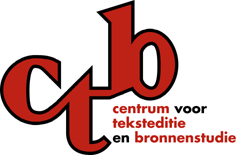 |
Centrum voor Teksteditie en Bronnenstudie |
Centre for Scholarly Editing and Document Studies |
|
a research centre of the Royal Academy of Dutch Language and Literature |
|
1. Introduction |
Up: Contents Next: 2. The DALF DTD
| Home
3. Overview of DALF document structure 5. Letter-specific textual features 6. Correlations of logical and physical structures 7. Modifications to TEI element classes Appendix A Reference documentation for DALF elements and classes |
The availability of correspondences of authors and composers with their family, friends and colleagues, musicians, critics, illustrators, publishers, etc. is of great importance to literary scholars as well as to (art) historians, linguists, cultural sociologists etc. Letters do give an insight in and provide valuable information about, for instance the writing or composing process of an author or a composer, the dating, meaning and reception of a work, and provide further biographical details. In view of its assignment to study and valorize the Flemish intellectual heritage, the Centre for Scholarly Editing and Document Studies (Centrum voor Teksteditie en Bronnenstudie - CTB) has launched the DALF project. DALF is an acronym for "Digital Archive of Letters in Flanders". It is envisioned as a growing textbase of correspondence material which can generate different products for both academia and a wider audience, and thus provide a tool for diverse research disciplines ranging from literary criticism to historical, diachronic, synchronic, and sociolinguistic research. The input of this textbase will consist of the materials produced in separate electronic edition projects. The DALF project can be expected to stimulate new electronic edition projects, as well as the international debate on electronic editions of manuscripts. In order to ensure maximum flexibility and (re)usability of each of the electronic DALF editions, a formal framework is required that can guarantee uniform integration of new projects in the DALF project. Therefore, the project is from the start aimed at adherence to international standards for electronic text encoding. An important formal standard used in the DALF project is XML, that enables the definition of structural text-grammars as Document Type Definitions (DTD). Also in the construction of such a DTD that is suitable for scientific markup of correspondence material, we tried to align with international efforts to define markup schemes. Without going into detail here, the insights and practices presented in international projects like TEI (Text Encoding Initiative), Master (Manuscript Access through Standards for Electronic Records), and MEP (Model Editions Partnership) were taken into consideration for the implementation of following requirements in a DTD for correspondence material:
The TEI encoding scheme provides an excellent starting point for many of the features one would like to encode in letters. Yet, letters have a number of specific elements that require additional encoding means. Since the TEI scheme can be extended when necessary, this is the approach taken for the development of the DALF DTD. This document explains in detail the letter-specific elements of the DALF DTD, and illustrates their use with a discussion and examples. It will not provide an introduction to the syntax and use of the XML markup language. The interested reader can find a list of introductory materials on XML on the Cover pages, and an excellent introduction on the use of XML for humanities computing in chapter 2. A Gentle Introduction to XML of the TEI P4 Guidelines. Neither does it provide in-depth coverage of all standard TEI elements in the DALF DTD; it assumes instead that the reader is familiar with those, and with the organisation of the TEI tagset. For full and excellent documentation of the TEI tagset the reader is referred to the TEI P4 Guidelines. In section 2 is explained how the DALF DTD extends the TEI scheme, and how both relate to each other. The 3rd section gives a brief overview of the major structural elements of DALF encoded letters. Of these, the specific DALF elements for the header are explained first in section 4. Later, specific DALF text elements are discussed in section 5. Section 6 analyses the problematic area of encoding physical and logical structures with an TEI-based encoding scheme in XML, and the provisions made in the DALF DTD to minimise those problems. Section 7 concludes with a discussion of modifications made to specific TEI element classes, for cases where the distribution of regular TEI elements was considered too narrow for the transcription of primary manuscript materials. |
Up: Contents Next: 2. The DALF DTD
Date: 2003 (revised 2005-05-04) Author: Edward Vanhoutte & Ron Van den Branden (revised Ron Van den Branden).
© Copyright CTB 2004